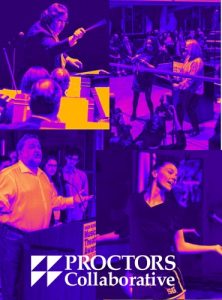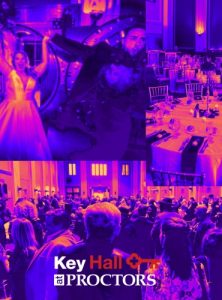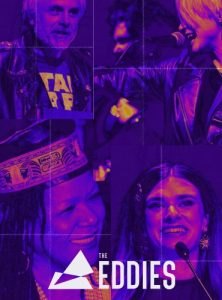Goldie: Mighty Wurlitzer
Glorious melodies of days gone by
Goldie’s 32 pedals, 250 stops and 1,400 pipes: Components of a ‘uniquely American instrument’
It’s got all the bells and whistles. It’s also got boat horns, sirens, surf sounds, birds, and whoopies! It is Goldie, the Mighty Wurlitzer theatre organ at Proctors
To hear Frank Hackert tell it, Goldie is a wonder of the modern age and “a uniquely American musical instrument.” And Hackert should know, he’s the chairman of the Hudson-Mohawk Theatre Organ Society. He helps to maintain Goldie, so talented musicians like his brother Carl—a Crane School of Music graduate and Music Director at St. Gabriel’s Church in Rotterdam—can play it.
Goldie, Hackert explains, was built in 1931, just as the theatre organ was being pushed out of style by talking films, spearheaded by Al Jolson’s groundbreaking “The Jazz Singer” in 1927. Prior to that, theatre organs provided a full range of sound and special effects for silent movies—everything from the portentous diminished chord for a horror film to the whoosh of a passing train for the western.
Unlike the church organ, meant for devotional music, processionals, and choral support, the theatre organ literally had all the above-mentioned bells and whistles.
Goldie still has them, hidden by black louvers above and to the sides of the stage, along with 1,400 pipes; drums; cymbals; xylophones; marimbas; and a whole mess of various special effect “toys” controlled by buttons at the organist’s feet. A Kimball baby grand piano, positioned to the right of orchestra seating can be played from the organ keyboard as well.
When Proctors opened in 1926, Hackert says, the vaudeville house was equipped with a three-manual mahogany console organ. But that instrument stayed in Schenectady only through 1957, when it was purchased and moved to a private residence in Massachusetts. The original organ was unseen by the audience, hidden in the orchestra pit but still allowing the organist to watch and accompany the on screen goings-on.
Goldie—built in North Tonawanda, New York, originally housed at the Paramount Theatre in Aurora, Illinois—did not arrive until 1983, four years after the initial rejuvenation of Proctors. A generous gift from the Golub Foundation allowed the organ to be transported from its then home in Minnesota to Schenectady. Now, Goldie rides a lift, which brings her to stage level, allowing her beauty to be seen while her voice is heard.
Goldie, Hackert points out is a 3/18 Wurlitzer, which means that the organ boasts three keyboards, 32 pedals, and 18 ranks—each of the latter made up of dozens of pipes representing various wind-blown members of the orchestra. The pipes range from less than a foot to 16 feet in length, creating a sonic range from a whisper to a roar.
The pipes are still driven pneumatically, with a series of bellows creating the breath of life for each note. As engineer and chapter vice president Dick Calderwood pointed out on a recent guided tour of the organ’s workings, there is nearly the equivalent of a jet engine beneath the theatre’s floor providing all that power. Pulling out all the stops takes some effort, there are 250 of them!
But Goldie is nothing if not modern. The innards of the organ itself have been modified with up-to-date electronics, which also make the instrument more portable. It can now be positioned more conveniently on the stage, depending on its intended use.
It is also fully MIDI-capable. MIDI, which stands for Musical Instrument Digital Interface, broadens the capabilities of Goldie even more. It also allows different players to design their own signature configurations of organ stops and to electronically record their performances.
Hackert says that legendary British organ designer and inventor Robert Hope-Jones dubbed the Wurlitzer “the unit orchestra” because it could cover the sounds of an entire band.
In the hands of players like Carl Hackert, Rob Kleinschmidt, and Avery Tunningley, it does just that, filling Proctors with glorious melodies of days gone by—movie themes, standards from the Great American Songbook, and radio favorites for singing along.






